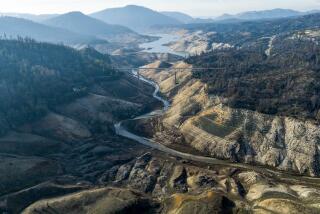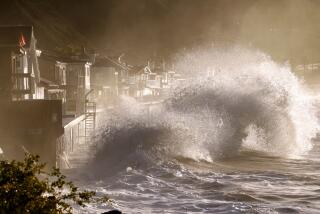Q&A: Is El Niño wimping out in Southern California? Not quite
Los Angeles is facing sunshine and warmth this week even as El Niño remains strong 1,000 to 2,000 miles south of California. It’s the third week without big storms this month. But El Niño is not wimping out. Here’s what’s going on:
Why hasn’t El Niño brought us rain already in Los Angeles?
Put simply, it’s too early for El Niño-influenced rains to arrive in Southern California.
During the last two strong El Niños on record, the heaviest rains came during February 1998 and March 1983, said Bill Patzert, climatologist for NASA’s Jet Propulsion Laboratory in La Cañada Flintridge.
Los Angeles has actually done well for rainfall in January. As of Monday, downtown recorded 109% of average rainfall this month, largely due to big El Niño-influenced storms the first week of January.
So why is L.A. so pleasant and sunny this week while even Northern California has been getting hit by rain and snow?
There are masses of high pressure sitting on top of Southern California and over Nevada right now.
“High pressure literally means there’s more air in the atmosphere above you. And it pushes down on the air. And when it does that, it compresses it, and it literally heats up through compression,” Patzert said.
“That’s why in a high pressure system, you get heat waves.”
That mass of high pressure “needs to flatten out and go away” for storms to return to Southern California, National Weather Service meteorologist Dave Bruno said.
What about the conveyor belt of storms we were promised?
That pattern did emerge in the first week of January, but hasn’t returned since then.
Why are some experts confident that the El Niño-style rains will come to Southern California?
The two biggest El Niños on record, which developed over 1982-83 and 1997-98, brought double the rain and double the snowpack for California, Patzert said. This El Niño is in the same league as those two.
El Niño is the warming of surface ocean temperatures about 1,000 to 2,000 miles south of California that fuels atmospheric disturbances worldwide. It’s 2.5 times the size of the continental United States.
What makes this El Niño very impressive is that it’s still so huge compared with the El Niño of January 1998, which was already contracting by then, Patzert said.
Periods of sunny and warm weather are typical even in strong El Niño winters, Bruno said. “No need to be alarmed that El Niño is a bust.”
Why would warm ocean temperatures 1,000 to 2,000 miles away from Southern California impact storms coming our way?
Think about the western Pacific Ocean. The ocean surface is warm, and there’s lots of clouds, rain and storms.
From Japan, those warm temperatures fuel the subtropical jet stream — a narrow band of strong winds in the atmosphere that pushes storms west to east. But that jet stream typically peters out in the middle of the ocean, around where the ocean’s surface starts cooling.
But during El Niño, when warmth arrives to the sea surface of the central and eastern Pacific Ocean, stormy energy comes with it, Patzert said. Think of it like a kick-starter for the subtropical jet stream.
“They energize a subtropical jet stream in the normally calm eastern Pacific,” Patzert said.
All that warm water “strengthens and elongates the subtropical jet stream,” Patzert said, and gives it a second life. Due east of Japan happens to be Southern California, and so the renewed subtropical jet stream aims for a collision course with Southern California and the southern United States.
See more of our top stories on Facebook >>
So when will those big storms finally show up?
We don’t know for sure. The L.A. forecast for the rest of the week is sunny or partly cloudy, with highs in the 70s. There’s a 40% chance of rain Sunday.
Forecasters don’t know whether that rain will be significant. One computer model suggests 1 inch of rain Sunday; another says it could be as little as 0.1 of an inch or 0.25 of an inch, said Bruno of the National Weather Service.
As for the first week of February, there were initial signs that a big series of storms could come, but that has since fizzled. “In February, the models are very inconsistent,” Bruno said.
Still, Bruno expressed hope that El Niño would come through.
During “the strong El Niños, just about every one has produced heavy rain for the winter. Until that track record is broken, we’re going to believe February and March are going to be met,” Bruno said. “I have faith in just the fact that the track record has proven that.”
The National Weather Service’s Climate Prediction Center forecasts above-average precipitation for California and the southern United States through the three-month period of March, April and May.
Has this winter been disappointing for rainfall in Southern California?
It depends on your point of view.
The National Weather Service recently changed the rain year for Los Angeles to begin Oct. 1. By that measure, L.A. has only 58% of the average rainfall to date, or 3.77 inches compared with the average of 6.54 inches as of Monday.
But that arbitrary date ignores the traditional rain year for L.A., which used to be July 1 through June 30 -- which neatly began during the driest period of the year.
The new rain year ignores the rain Southern California received in September when the remnants of Hurricane Linda washed ashore, dumping more than 2 inches of rain on downtown.
The old rain year would put downtown L.A. at 6.54 inches of rain since July 1 -- about 97% of the average of 6.72 inches.
January has been decent for Los Angeles. Downtown L.A. recorded 2.74 inches of rain since New Year’s Day, which is slightly above the average so far this month of 2.51 inches.
The snowpack is a really important indicator of California’s water supply. How are we doing on that?
The water content in the snow in the northern Sierra Nevada on Monday was pegged at 129% of average for Monday. For the central Sierra, it was 118% of average and for the southern Sierra, 99%.
State officials say the snowpack water content needs to be at 150% of average to come close to digging California out of the drought. That’s an ambitious benchmark that will be difficult to achieve, and it’s more likely that California will be about average for the year, officials say.
What do water managers think about the recent rain and snow?
They’re optimistic, but point out that the reservoirs are so low that it will probably take more than one year of above-average rain and snow to recover. For instance, California’s fourth-largest reservoir, New Melones, is only at about 15% of capacity.
The Southland’s chief importer of water, the Metropolitan Water District of Southern California, has exhausted two-thirds of its drought backup supply. And it’s unclear how much Southern California will get from water supplies in the north later this year.
Even an average year of rain and snow might result in Southern California getting only half of what it wants from the State Water Project, a vital aqueduct that supplies the south with water from the mountainous north, said Deven Upadhyay, manager of the water resource management group at the MWD.
Follow me for the latest news in earthquake safety, El Nino, and the drought: @ronlin
See more of our top stories on Facebook >>
ALSO
As inmate manhunt continues, experts dissect why it took so long to detect their escape
Yoga guru Bikram Choudhury must pay $900,000 to former employee, jury decides
Almost 7,500 volunteers are signed up to help count L.A. County’s homeless







